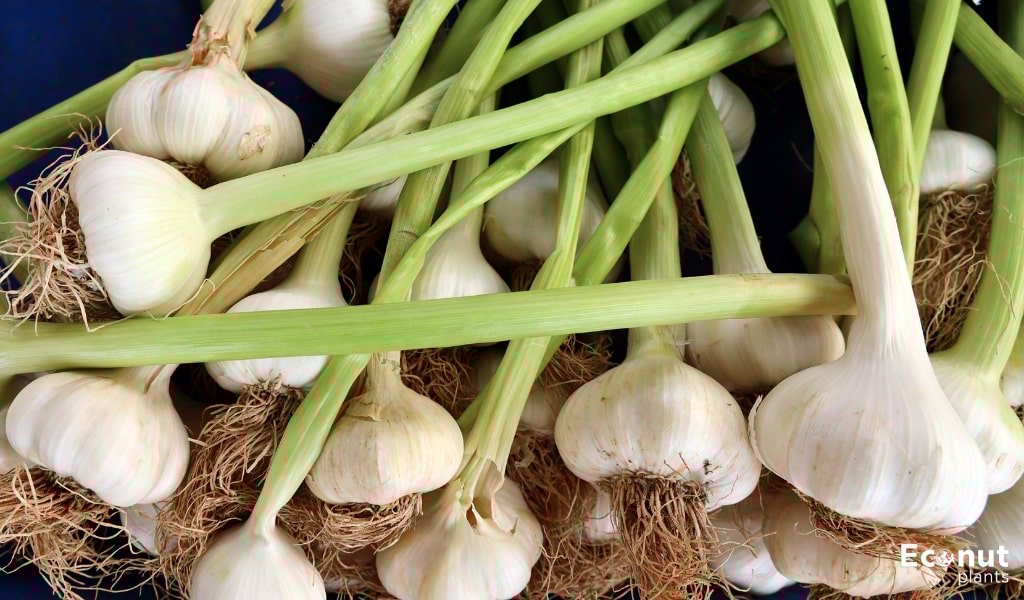Garlic is what most people know it as. Before I learned that there are two varieties of garlic—soft neck and hard neck—it was the same for me. These days, one of my favourite falltime hobbies is planting the hardneck type in my backyard garden.
One of the extra benefits of hard-neck garlic is that it produces garlic scapes, which is why I like to plant it. I go into greater detail about what garlic scapes are today, as well as how to cultivate and plant hardneck garlic and why it’s the kind you should plant.
Hardneck Garlic Overview
| Common Name | Stiffneck, hard neck, or topset garlic |
| Scientific Name | Alliums sativum var. ophiscorodon |
| Germination Time | Two to four weeks |
| Day to Harvest | 180-210 days |
| Light | Full Sun |
| Soil | Well-drained Soil |
| Fertilizer | 5-10-10 Complete fertilizer |
| Pests | Thrips, bulb mites |
| Diseases | Botrytis neck rot, downy mildew |
Hardneck vs. Softneck Garlic
What differentiates softneck and hardneck variations from one another? It all comes down to what differentiates them physically. Hardneck garlic has a hard stem in the center, unlike softneck garlic. Compared to softneck garlic, which is often papery and a little trickier to peel, hardneck garlic has skin that is typically thicker and more brittle.
Softneck garlic cultivars are the ones you usually find in grocery shops. Compared to softneck bulbs, which have fewer cloves per bulb, hardneck bulbs have smaller seeds. Furthermore, softneck cultivars mature more quickly and have longer-lasting bulbs.
However, softneck garlic does not yield the same excellent results as hardneck garlic. A flower stalk emerges from the mature hardneck garlic plant. Once it curls, but before it flowers, cut off this tasty stalk, known as a scape, from the plant. Scapes taste mildly like garlic and have a texture similar to asparagus when stir-fried.
Growing hard-neck garlic
It’s simple to plant hardneck garlic by simply removing the cloves from the bulb and placing them in the ground.
It’s simple to plant hardneck garlic by simply removing the cloves from the bulb and placing them in the ground. The smaller cloves will produce larger bulbs, so be careful when storing them for cooking.
Where to Plant Hardneck Garlic
It takes time for all garlic to mature, so you may need to set aside a sizable area for your garlic bed. It emerges in the early spring, and in the summer, it is harvested.
After harvesting, fill in the gaps with a vegetable that grows quickly, such as kale, spinach, or radish. It’s a fantastic companion plant for many garden veggies.
When to Plant Hardneck Garlic
Hardnecks are often planted in mid-October during the autumn. This allows them to take root before the snow arrives and the ground freezes. This is one of the first green sprouts to emerge in the spring.
How to Plant Hardneck Garlic
All set to grow garlic? Pull each clove apart from the bulb. Press the 2–3 inches into the ground. Check to make sure the pointed end is facing upward. Plant the cloves 6′′ apart or more, with rows spaced roughly 10′′ apart.
My inability to have enough room for proper spacing was the issue. I finally packed the cloves four inches apart. The next season, the bulbs and the stalk were both very small. To protect them from cold weather, mulch newly planted areas with leaves, grass clippings, or straw down to a depth of 4 inches.
Hardneck Garlic Care
Soil
Hardneck garlic thrives on most soil types as long as they drain well, although it likes sandy loam. If the bulbs remain in standing water for an extended period, they may become rotten. Composted soil—which is thick clay—will gradually improve with regular maintenance.
Watering
Water garlic well every eight to ten days or roughly one inch every seven days. After harvesting the scapes, stop watering.
Light and Temperature
Hardneck garlic can tolerate severe winter temperatures because of its cold tolerance. Even in areas with short growing seasons, Alliums sativum grows well as long as it receives full sun. In the absence of heat, a clove splits into internal segments that eventually grow into the heads, a process known as verbalization.
Refrigerated garlic will detect that it has come into contact with chilly air. The ideal location is one where it can naturally reach the lower temperatures it requires.
Fertilizer
Hardneck garlic is a heavy feeder and needs high-nitrogen fertilizer due to the considerable time it takes for alliums to generate scapes and later bulbs.
Fertilize a few more times after planting, in the spring and early summer. Stopping before the scapes grow will prevent you from having beautiful leaves but small bulbs. To promote general plant health, provide a balanced fertilizer supplement.
Plan: Before planting in the fall, add manure or compost to the soil. This will give your soil more nutrients, enhance its quality, and help it hold onto the ideal amount of moisture.
Propagating
Hardneck garlic can be grown in two ways: either by planting bulbils or cloves. Garlic scapes will grow into little bulbs called bulbs.
Garlic bulbils require two or three years to grow into large enough bulbs to consume; however, planting individual cloves will yield bulbs in a few months. The more common approach is to produce garlic bulbs from cloves.
Harvesting and Storing Hardneck Garlic
We suggest reading our comprehensive advice on when to harvest garlic because there are differences in the ways of harvesting the two species of garlic. It can be difficult to store, so here are six various ways you can do it!
Problems
The first lines of defence against bothersome pests and diseases are growing certified disease-free garlic seed and rotating crops. While growing hardneck garlic is usually not a very dramatic process, there are a few pests and illnesses to be aware of.
Pests
Thrips are the most prevalent pest for garlic. Their ability to draw sap from the plant and survive may hinder the proper growth of bulbs. For a moderate infestation, neem oil or insecticidal soap works well.
Bulb mites, like spider mites, gather in garlic’s and other alliums’ roots. The bad news about bulb mites is that they are exceedingly hard to get rid of naturally without the use of matricides. Predatory mites are an excellent way to reduce thrips and bulb mites if you want to experiment with beneficial insects.
Diseases
Blackening on your garlic stems just above the soil line could be the result of Botrytis neck rot, also known as Botrytis allii. It is more likely to manifest after harvest due to bulb bruising, inadequate curing, or inadequate storage. The best ways to prevent it are to plant disease-free cloves, handle bulb harvesting gently, and refrain from overwatering.
Downy mildew is another fungus that can infiltrate your garlic crop very quickly. In moist soil conditions, soil spores proliferate. Keep an eye out for rapid-spreading yellow discoloration on foliage that starts on the undersides of the leaves.
Avoid overwatering, plant seeds free of diseases, and maintain ventilation between plants. Neem oil can be sprinkled on afflicted plants.
FAQ
Which is better, hardneck or softneck garlic?
Depending on where you live, in colder climates, hardnecks are typically easier to deal with than softnecks. They also have a stronger flavour.
How can I decide which type of garlic to plant—hardneck or softneck?
While most garlic types are grown in warmer climates, hardneck varieties thrive in colder climates. Look for common types that are growing nearby. Each variety has several widely dispersed cultivars.
If I don’t gather scapes, will my garlic bulbs be small?
There are differing opinions available regarding this subject. I’ve heard anecdotally from friends and from personal experience that plucking scapes encourages bulb growth. Plus, scapes taste great!

